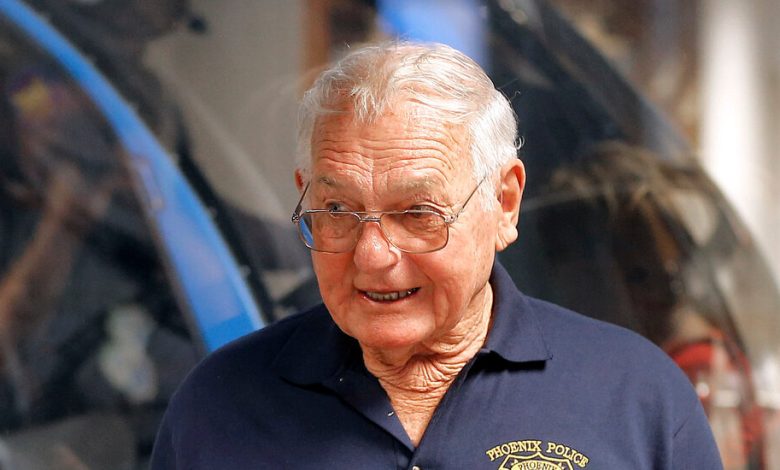Carroll Cooley, Detective in Landmark Miranda Case, Dies at 87

Carroll Cooley, a detective whose interrogation of a rape suspect named Ernesto Miranda helped lead to the landmark decision by the Supreme Court that compelled the police to make criminal suspects aware of their right against self-incrimination and their right to have a lawyer present, died on May 29 at his home in Phoenix. He was 87.
His wife, Gleora (Caron) Cooley, said the cause was chronic obstructive pulmonary disease.
Mr. Cooley had been a detective in the Phoenix Police Department for about a year when he and a colleague pursued Mr. Miranda for the rape and kidnapping of an 18-year-old woman in March 1963. Mr. Miranda was found at his home and brought to the police station.
He wasn’t handcuffed because he was not yet under arrest, Detective Cooley said during a speaking engagement in 2016 quoted in an article in The Arizona Republic, and he wasn’t told that he needed a lawyer because there was no legal requirement to do so.
At the police station, the victim identified Mr. Miranda — published accounts differ over whether it was in a lineup or a direct confrontation — and, after being interrogated by the detectives, he wrote out a confession which started: “Seen a girl walking up street stopped a little ahead of her got out of car walked towards her grabbed her by the arm and asked to get in car. Got in car without force tied hands and ankles.”
Mr. Miranda signed the confession at 1:30 p.m. on March 13 and swore that he had written it of his own volition. Fifty-three years later, in the article in The Republic, Detective Cooley vehemently denied having told him what to write.
Carroll Franklin Cooley was born on Aug. 25, 1935, in Bald Knob, Ark. With the Great Depression luring people west for opportunities, he soon moved with his family to Phoenix. His father, John, was a car mechanic who later owned a small airport and a salvage yard. His mother, Donna Mae (Whittaker) Cooley, was a homemaker.
Carroll Cooley joined the Phoenix police in 1958 and was promoted to detective a few years later. He received a bachelor’s degree in 1977 from St. Mary’s College of California, in Moraga, which had a program in public management at Arizona State University.
The Miranda case was by far the most significant of Detective Cooley’s law enforcement career. Mr. Miranda was convicted of rape and kidnapping by a Superior Court jury in June 1963; the conviction was upheld nearly two years later by the Arizona Supreme Court, which ruled that his confession was admissible despite his not having had a lawyer present.
In late 1965, the U.S. Supreme Court agreed to review four cases, including Mr. Miranda’s, in which indigent men had confessed after being interrogated. The next year, the court ruled 5 to 4 that the Fifth Amendment required the police to advise suspects that they had the right to remain silent once they were in custody and to have an attorney present during interrogations. The rights, almost from the day of the decision, became known as the Miranda warning.
Mr. Miranda’s conviction was overturned by the Supreme Court, but he was retried on rape and kidnapping charges and found guilty again in 1967. (The confession was not used in that trial.) He was paroled in 1972 and stabbed to death four years later in a barroom fight. After his death, it was reported that he had been trading on his legal celebrity by selling Miranda warning cards for $1.50 each.
In addition to his wife, who is known as Glee, Mr. Cooley is survived by a son, Farrell, and a daughter, Brenda Barcellos, from his marriage to Lois Ellis, which ended in divorce; a stepson, Mark Scheiter; a stepdaughter, Caron Reynolds; 12 grandchildren; and 18 great-grandchildren. Another son, Kenneth, died in 2014.
Detective Cooley was eventually promoted to captain and retired from the Phoenix Police Department in 1978. He later worked as an adjunct professor in the police certification program at the University of Illinois Urbana-Champaign; an administrator of the state of Arizona’s motor vehicle division; and a commander of the state’s highway patrol division.
He was also a volunteer at the Phoenix Police Museum, which unveiled a permanent exhibit about the Miranda case in 2013.
Detective Cooley disagreed with the Supreme Court’s decision in Miranda v. Arizona and believed that it hampered crime-fighting, his wife said by phone.
In 1976, he defended his actions in the Miranda case to The Republic, saying that Mr. Miranda’s confession had been written voluntarily and that Mr. Miranda knew his rights.
“He was not un-knowledgeable about his rights,” he said. “He was an ex-convict and served a year in prison” — for auto theft — “and had been through the routine before.”
But Yasmin Cader, a deputy legal director for the American Civil Liberties Union, said by email that the Miranda decision made the guarantees of the Constitution a reality.
“The purpose of Mirandawarnings is to make the Fifth Amendment’s right against self-incrimination understandable and available to those who find themselves at the other end of the government’s finger,” she wrote.
She added, “Unfortunately, in recent years the Supreme Court has made it more difficult for people who have been denied their Miranda rights to seek a remedy in court,including in Vega v. Tekoh” — a case last year in which the court ruled that police officers may not be sued for failing to administer Miranda warnings. “But the obligation of law enforcement to issue affirmative Miranda warnings remains the same: Inform the accused of their constitutional rights.”




